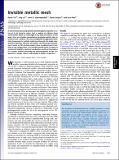| dc.contributor.author | Ran, Lixin | |
| dc.contributor.author | Ye, Dexin | |
| dc.contributor.author | Lu, Ling | |
| dc.contributor.author | Joannopoulos, John | |
| dc.contributor.author | Soljacic, Marin | |
| dc.date.accessioned | 2016-11-04T18:40:08Z | |
| dc.date.available | 2016-11-04T18:40:08Z | |
| dc.date.issued | 2016-02 | |
| dc.date.submitted | 2015-11 | |
| dc.identifier.issn | 0027-8424 | |
| dc.identifier.issn | 1091-6490 | |
| dc.identifier.uri | http://hdl.handle.net/1721.1/105204 | |
| dc.description.abstract | A solid material possessing identical electromagnetic properties as air has yet to be found in nature. Such a medium of arbitrary shape would neither reflect nor refract light at any angle of incidence in free space. Here, we introduce nonscattering corrugated metallic wires to construct such a medium. This was accomplished by aligning the dark-state frequencies in multiple scattering channels of a single wire. Analytical solutions, full-wave simulations, and microwave measurement results on 3D printed samples show omnidirectional invisibility in any configuration. This invisible metallic mesh can improve mechanical stability, electrical conduction, and heat dissipation of a system, without disturbing the electromagnetic design. Our approach is simple, robust, and scalable to higher frequencies. | en_US |
| dc.description.sponsorship | National Natural Science Foundation (China) (Grants 61401393 and 61131002) | en_US |
| dc.description.sponsorship | China Postdoctoral Science Foundation (Grant 2014M550325) | en_US |
| dc.description.sponsorship | United States. Army Research Office. Institute for Soldier Nanotechnologies (Contract W911NF-13-D-0001) | en_US |
| dc.description.sponsorship | National Science Foundation (U.S.). Materials Research Science and Engineering Centers (Program) (Award DMR-1419807) | en_US |
| dc.description.sponsorship | Solid-State Solar-Thermal Energy Conversion Center | en_US |
| dc.description.sponsorship | United States. Dept. of Energy (Energy Frontier Research Center. Grant DE-SC0001299) | en_US |
| dc.language.iso | en_US | |
| dc.publisher | National Academy of Sciences (U.S.) | en_US |
| dc.relation.isversionof | http://dx.doi.org/10.1073/pnas.1600521113 | en_US |
| dc.rights | Article is made available in accordance with the publisher's policy and may be subject to US copyright law. Please refer to the publisher's site for terms of use. | en_US |
| dc.source | PNAS | en_US |
| dc.title | Invisible metallic mesh | en_US |
| dc.type | Article | en_US |
| dc.identifier.citation | Ye, Dexin et al. “Invisible Metallic Mesh.” Proceedings of the National Academy of Sciences 113.10 (2016): 2568–2572. | en_US |
| dc.contributor.department | Massachusetts Institute of Technology. Institute for Soldier Nanotechnologies | en_US |
| dc.contributor.department | Massachusetts Institute of Technology. Department of Physics | en_US |
| dc.contributor.mitauthor | Ye, Dexin | |
| dc.contributor.mitauthor | Lu, Ling | |
| dc.contributor.mitauthor | Joannopoulos, John | |
| dc.contributor.mitauthor | Soljacic, Marin | |
| dc.relation.journal | Proceedings of the National Academy of Sciences | en_US |
| dc.eprint.version | Final published version | en_US |
| dc.type.uri | http://purl.org/eprint/type/JournalArticle | en_US |
| eprint.status | http://purl.org/eprint/status/PeerReviewed | en_US |
| dspace.orderedauthors | Ye, Dexin; Lu, Ling; Joannopoulos, John D.; Soljačić, Marin; Ran, Lixin | en_US |
| dspace.embargo.terms | N | en_US |
| dc.identifier.orcid | https://orcid.org/0000-0002-7244-3682 | |
| dc.identifier.orcid | https://orcid.org/0000-0002-7184-5831 | |
| mit.license | PUBLISHER_POLICY | en_US |
| mit.metadata.status | Complete | |
